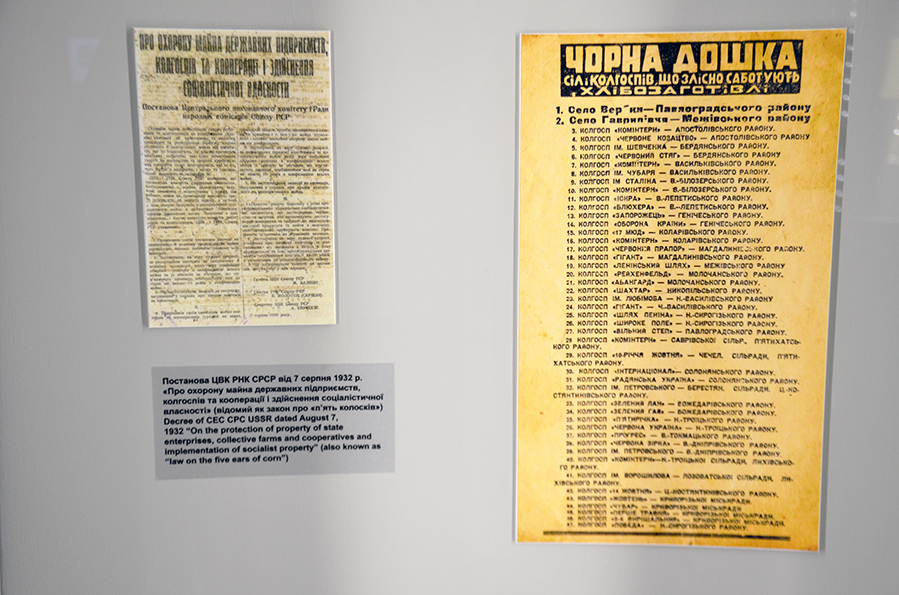Today, reading print media has become a kind of relic of a bygone era, a tribute to habit and traditions. The rapid flow of life, the relentless development of multimedia technologies and the demand for instant access to the necessary information forces the most authoritative world publications to abandon paper editorials in favor of electronic versions in the worldwide information network. Even though certain periodicals are still faithful to the traditions, we can assume that eventually we will meet most of them, either in the form of scanned copies in electronic libraries or in museum exhibits.
The collection of Museum “Jewish Memory and Holocaust in Ukraine” contains an array of printed publications, which can be traced back to a number of significant events in Ukrainian and Jewish history: World War II, the Holocaust, anti-Semitic campaigns of the Stalin and Brezhnev era, the Cold War.
Thus, in the block of permanent exposition dedicated to the genocide of the Ukrainian peasantry of 1932-1933, there is one of the publications of the central printed edition of the Dnipropetrovsk region - the newspaper “Zorya” – the official mouthpiece of the Dnipropetrovsk regional committee of the Communist Party (Bolsheviks) of Ukraine / CP(b)U. The newspaper column imprinted one of the most tragic stories in national history – the practice of the Soviet authorities using the so-called “black boards” as a method of subjugating and punishing the Ukrainian peasantry, doomed to starvation.
Writing on the “blackboard” as an intangible method of increasing motivation was not an invention of Russian Bolshevism. Back in the 19th century. in some educational institutions of the Russian Empire, students with unsatisfactory academic performance were put on “blackboards” (at the same time, there were “boards” on which the best ones were noted). In the mid-1920s, in the Soviet press, which was supposed to stimulate the enthusiasm of the workers, there were calls to “put on the blackboard” (in other words, “on the wall of shame”) individuals or labor collectives whose activities did not meet the party's expectations in terms of speed and scale. economic transformations. The collectivization campaign, the bread crisis contributed to the fact that the “blackboards” method began to be used on the front of the “class struggle in the village”.
However, it was during the grain procurement campaign (by the way, evaluate the actual military rhetoric used by the authorities in the USSR) of 1932 that the “blackboard” turned into one of the elements of the most brutal repression, which should have been applied to settlements and collective farms, which “maliciously sabotaged” the implementation of the bread delivery plan.
On November 20, 1932, the Council of People's Commissars of the Ukrainian SSR (RNC of the Ukrainian SSR) adopted the Resolution “On the fight against kulak influence in collective farms”, which approved the instruction on the use of repressive measures against individual collective farms listed on the “blackboard”. Specific actions in particular included:
Immediate termination of delivery of goods, cooperative and state trade. Already available goods in stores were subject to immediate and complete removal.
Suspension of lending and early recovery of previously issued loans and other financial obligations of collective farms, collective farm owners and sole proprietors.
Checking the composition of collective farms and cleaning them from “counter-revolutionary elements – organizers of disruption of grain procurement.”
Обов’язок заносити колгоспи на «чорні дошки» покладався на обласні виконавчі комітети.
In fact, the Bolshevik authorities once again resorted to the method of collective repression, the purpose of which was to punish and intimidate those collective farms to which such measures had not yet been applied.
Subsequently, on December 6, 1932, the Resolution of the Central Committee of the Communist Party (Bolsheviks) of Ukraine and the RSC of the Ukrainian SSR “On blacklisting villages that maliciously sabotage grain procurement” was issued. Thus, not only members of collective farms, but also all residents of settlements, regardless of whether they were engaged in agricultural business, were subject to punishment.
The aforementioned publication of the newspaper “Zorya” dated January 27, 1933 contained a list of 45 collective farms and 2 villages of the Dnipropetrovsk region (which at that time included part of the territory of the modern Zporizhzhia and Kherson regions). It is worth pointing out that since the 1920s, national districts were created on the territory of the USSR, as part of the so-called “indigenization” course, within the compact residence of individual ethnic groups. Thus, in the Dnipropetrovsk region there were Bulgarian, Jewish, German, etc. Looking at the list mentioned above, one can see that among those punished were, in particular, 2 collective farms from the Kolarivsky (Bulgarian) and 2 collective farms from the Molochansky (German) national districts.
Later, other settlements were added to the list of victims of totalitarian punishment.
“Blackboards” were one of the elements of the genocide, but not the only one. At the end of 1932, decisions were made on the introduction of a unified passport system in the USSR and the introduction of registration rules and, as a result, the establishment of restrictions on movement and changing the place of work. The exception to the “passport rules” was actually the largest group – those who lived in rural areas. Such an approach made it impossible to legally move the peasants and actually doomed them to starvation.
“Freed” by the achievements of the so-called “October Revolution”, Ukrainian peasants will remain hostages of the Soviet regime for almost four decades, until the moment when the red booklet of the passport will be available to all citizens of the country of “workers and peasants”. The authorities of the latter, having used the entire supply of experimental ideas in the field of agriculture and destroyed effective producers, in 1961 for the first time (and since 1963 – annually) imported grain for domestic needs from abroad. Including buying it in Canada and the USA.
Yehor Vradii

